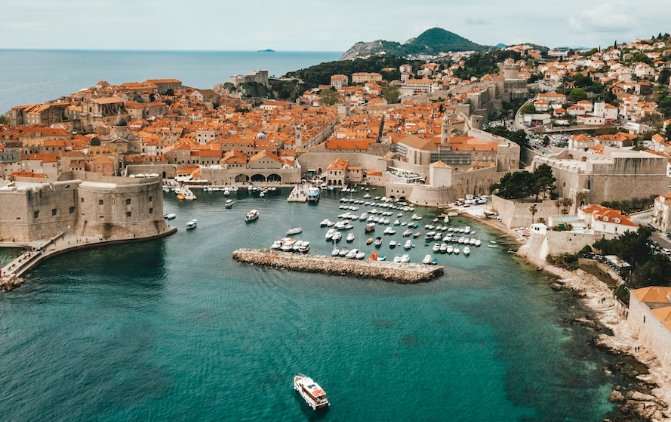A Guide to Angel Island: A Must-See San Francisco Gem

How to Take the Perfect Travel Photo
November 5, 2024
The Quirkiest, Nostalgic, And Strangest Airbnbs on Route 66
November 10, 2024When it comes to the islands of San Francisco Bay, Alcatraz’s famous prison attracts all the attention. But on the other side of Prison Island is another gem of the Bay Area: the often-overlooked Angel Island.
Throughout Angel Island’s history, the 740-acre site has had many uses, including Native American hunting grounds, shipbuilding lumberyards, cattle ranches, Civil War military bases, quarantine stations, newcomer U.S. immigration stations, missile defense bases, and California state parks since the ’20s.

Today, Angel Island State Park is known for its 13-mile hiking trails,9 miles of bike paths,740 acres of explorable wilderness and jaw-dropping bay views, and a complex and bizarre history just by fast ferry. Leave. This is the perfect countryside excursion for city dwellers who want to hike, bike, camp, boat, and more.
What to do on historic Angel Island? Read on to find out what we’re all missing.
Take the Ferry to Angel Island
Heading to Angel Island is also part of the fun. Angel Island State Park is only accessible by boat, either by public or private boat. Ferries are the easiest, let alone the cheapest, for most people, and cruising in the open water of San Francisco Bay never seems to lose the thrill.
Passengers board the ferry from Tiburon, California to Angel Island, which is located on the other side of San Francisco Bay, California.
Ferries depart from San Francisco and Tiburon, and park admission is included in the ferry ticket. Services from San Francisco are operated by Golden Gate Ferry, which takes 30 minutes from the San Francisco Ferry Terminal at the San Francisco Ferry Building to Angel Island. Angel Island-Tiburon Ferries depart from Tiburon Ferry Terminal in central Tiburon and can be reached in just 15 minutes.
Ferries arrive at Ayala Bay, a natural harbor on the northwest side of the island with a ferry terminal, popular beaches, visitor centers, beachfront seating, public jetties and picnic grounds. From there, you choose your own adventure.
Angel Island ferry frequencies vary seasonally and service decreases during the low season from November to February. It is recommended that you check the ferry schedule before departure as services may be changed or cancelled.
Boat on Angel Island
Taking the ferry isn’t the only way to get to Angel Island. Do you have a sailboat or pontoon that you want to sail on the bay? Take a boat ride to Angel Island. Ayala Cove offers boat slipway and mooring buoy rentals on a first-come, first-served basis. The slides used during the day are 30 to 50 feet long and open year-round from 8 a.m. to sunset. Mooring buoys can be used overnight, up to seven nights, and boaters can enter the island by dinghy until 10 pm For those mooring their own vessels, please note: due to the turbulent currents near the Raccoon Strait, the vessel must be secured at the bow and stern with the bow facing northeast. Please call the ranger station for more information and to see if there are vacancies:415-435-5390.

Bike Angel Island
Nine miles of bike paths welcome cyclists to Angel Island. These include a perimeter road that winds along the cliff coast, as well as an unpaved ring of fire roads that surround the interior of the island’s forest. Most of the island is made up of gently rolling hills, with some steep uphills and downhills, as well as gravel and paved paths. For the safety of hikers, bicycles are not allowed on the trail, but bike racks are available at the start of the trail to store bikes for short distances.
Bike hire is available seasonally in Ayala Cove, or you can bring your own bike on board the ferry upon arrival. Note: Personal e-bikes are not allowed on Angel Island, nor are skateboards, scooters, skates, or rollerblades allowed.
Picnic at Angel Island
If you’re going to Angel Island, a picnic is a matter of course: being surrounded by nature is the only way to eat. Angel Island offers park options for picnickers, from waterfront seating at Ayala Bay to the numerous picnic areas dotted around the island, including the main picnic spot at the top of Livermore Hill.
Once on the island, if you find a sandwich in a brown bag that can’t be cut, head to Ayala Cove’s snack bar, next to the Angel Island Café, which is currently undergoing renovations. Open seasonally, the snack bar offers grab-and-go snacks, water, drinks, beer and wine for easy to carry and take with you. Pre-made sandwiches and salads are available on weekends.
Hike to the Summit of Mount Livermore
For many of us, Angel Island is synonymous with hiking. Hikers come from far and wide to the top of Livermore Mountain to enjoy the stunning scenery. Two of Angel Island’s trails — the Northridge Trail and the Sunrise Trail — make up an off-the-beaten-path route, gradually climbing 788 feet to the highest point on the island. From the summit, hikers can enjoy unspoiled 360-degree views of the entire Bay Area.
Hikers should allow 2.5 hours for this round-trip hike, and may need more if you plan a picnic at the top of the mountain. Angel Island’s trails are well-maintained and well-marked, so as long as you stick to the designated path, you can avoid most hazards such as poisonous oaks, ticks, and dangerous terrain.

Take a Tram Tour of Angel Island
Pay per person and book in advance, and you can take an open-air streetcar tour of Angel Island Disneyland in style. With a capacity of up to 50 people, the Angel Island Tram takes visitors to visit and take photos of the island’s many historic sites on its way to the Angel Island immigration station. The trolley guide and audio recordings will fill in the gaps you see, giving you a comprehensive picture of what Angel Island State Park has to offer. For some, the tram tour will be the main activity; For others, it will be a springboard for further island adventures.
Visit the Exhibition on Angel Island
Exhibits throughout the island detail Angel Island’s century-long military history and history as a U.S. immigration station, where 500,000 immigrants were processed, interrogated and detained from 1910-1940.1 The island is also home to a museum, a museum, and a cafeteria. Visitors can view these exhibits and more at the Visitor Center in Ayala Cove, the Angel Island Immigration Station Museum on the north shore of the island, the Internment Camp Museum and World War II Dining Hall near the immigration station, and the Fort McDowell Chapel and Guardhouse on the east side of the island.

As with all services on Angel Island, please check the days and hours of operation prior to your visit as they vary throughout the year. You can always call 415-435-5390 for more information.
Camping on Angel Island
Why not spend a great night under the stars? Camping on Angel Island is one of the only ways to enjoy the island after nightfall.
There are 12 rural campgrounds scattered around the island, including an ADA campsite, a kayak campground for 20 people, and a group campsite for 30 people. Pro tip: Campsite bookings are quick if you’re planning a weekend trip, so you’ll need to plan months in advance if you’re looking to get one. Any unbooked campsite is available on a first-come, first-served basis – you’re more likely to get that luck during the week.
Angel Island Campground is a hiking/biking site perfect for those who don’t mind dragging their gear for two miles through the hills. (The ADA site is about a mile from Ayala Bay and follows a level, flat perimeter road.) At each stop, you’ll find running water, pit toilets, tables, food lockers (a must-have for cunning raccoons lurking), and barbecue grills. Fires are not allowed on the island (because of the obvious risk), so if you have a hot meal on the menu, you’ll need to bring charcoal or a camping stove.
Angel Island kayaking
Kayaking is a great way to explore every corner of Angel Island, especially some of the more remote coastlines, such as the hard-to-reach Sand Spring Beach. But be warned: kayaking Angel Island is not for newbies. Rushing currents, high winds, rapidly changing environments, and the bay’s famous fog require skill and confidence to navigate. If you’re eager to go kayaking on Angel Island, let a professional guide you. Sea Trek, a water sports equipment provider in Sausalito, offers guided island services, including an open water crossing and a 10-mile round-trip paddle trip around Angel Island.



